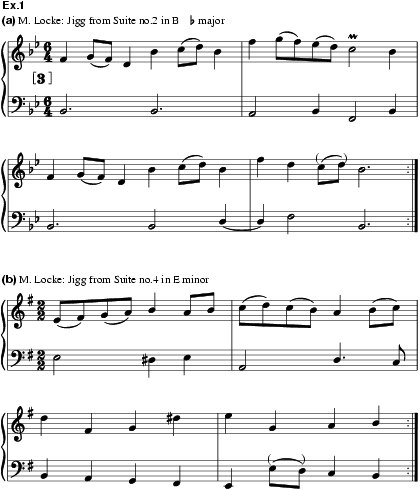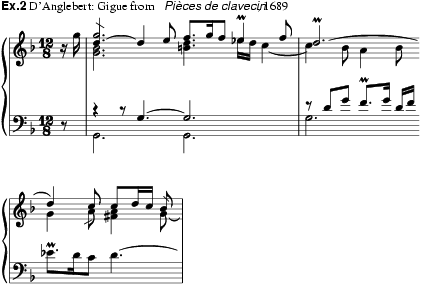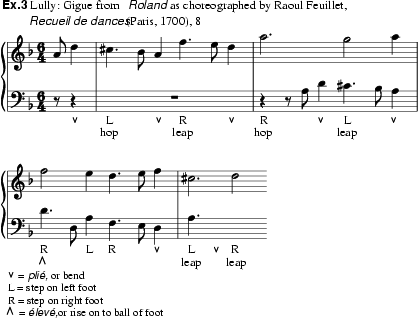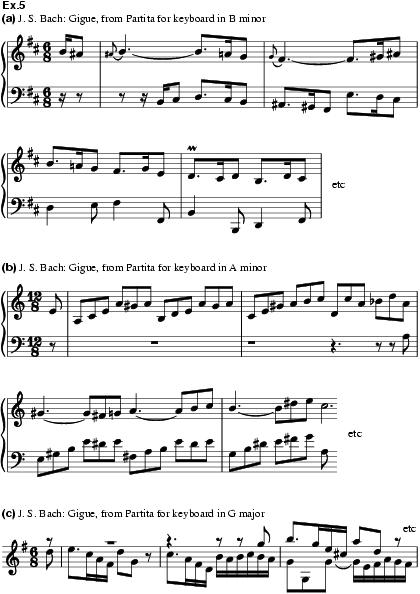
(Fr.: ‘jig’; It. giga, gighe).
One of the most popular of Baroque instrumental dances and a standard movement, along with the allemande, courante and sarabande, of the suite. It apparently originated in the British Isles, where popular dances and tunes called ‘jig’ have been known since the 15th century. Although 17th-century gigues were notated in simple duple metre, most are in some kind of compound metre (i.e. with a triple subdivision of the duple beats), and most are in binary form. During the 17th century, distinct French and Italian styles emerged. The French gigue was written in a moderate or fast tempo (6/4, 3/8 or 6/8) with irregular phrases and an imitative, contrapuntal texture in which the opening motif of the second strain was often an inversion of the first strain’s opening. The Italian giga sounded much faster than the French gigue but had a slower harmonic rhythm; it was usually in 12/8 time and marked ‘presto’, with balanced four-bar phrases and a homophonic texture. From about 1690 gigues and gigas appeared that were highly complex virtuoso solo pieces which used a wide variety of compositional techniques, usually with joyful affect.
The various words for the dance form known as the jig or gigue have rather confused histories that in turn have led to confusion about the origins of the musical form. In French, Italian and German, the word seems to be derived from a medieval word for fiddle (as in Dante, Paradiso, xiv.110: ‘E come giga ed arpa in tempratesa, Di molte corde, fan dolce tintinno’), a word also used to refer to the musician who played such a fiddle (see Gigue (ii)). The usage survives in modern German as Geige (violin), a survival that has contributed most to past uncertainty about the gigue’s origin. It is now believed that if the English word came from the Continent, it came not from gigue or fiddle but rather from the verb ‘giguer’, to frolic, leap or gambol. Although no choreographies have survived for the 16th-century jig, contemporary literary references suggest that jigs were fast pantomimic dances for one or more soloists with lively rhythms created by virtuoso footwork, and that they were somewhat bawdy (Shakespeare, Much Ado about Nothing, Act 2 scene i: ‘Wooing is hot and hasty like a Scottish jigge’). Dean-Smith pointed out that the word ‘jig’ may have derived from slang in a manner similar to the more recent evolution of the word ‘jazz’, becoming a generic term encompassing many forms of non-aristocratic music and dance. As with the first American meaning of the slang ‘jass’, most 16th-century connotations of the English word ‘jig’ were vulgar.
Sung and danced jigs were a prominent feature of the stage entertainment called Jigg, an improvised, farcical, burlesque comedy for two to five actors, developed in Elizabethan England and enthusiastically adopted in Scandinavia and northern Germany. Cotgrave’s definition of ‘jig’ as ‘strambot’ (Dictionarie of the French and English Tongues, 1611), a form of Italian frottola poetry adapted by the French for satiric and insulting verse, probably refers to the prevalence of such verse in theatrical jigg performances. Little is known about either the music or the dances used in jiggs; verses were sung to popular tunes, some of which remained well known in instrumental versions (e.g. Walsingham, Goe from my window, Watkins Ale, Spanish Pavan). It is possible that the style of the original dance accompaniments is reflected to some extent in these pieces, and in the jigs that appeared in English art music at the turn of the 17th century.
Jigs began to appear in English collections of instrumental music early in the 17th century, as independent pieces in binary form, as themes for variation sets, and occasionally as movements of longer works. Collections such as Antony Holborne’s The Cittharn Schoole (1597), Thomas Robinson’s Schoole of Musicke (1603), Thomas Ford’s Musicke of Sundrie Kindes (1607) and the Fitzwilliam Virginal Book contain pieces explicitly entitled ‘jig’ or ‘gigg’, as well as versions of some of the tunes thought to be associated with theatrical jiggs. The actual jigs are all written in four-bar phrases with a homophonic texture, some of them in simple duple metre (i.e. C or ) and some in compound duple (i.e. 6/4, 6/2 etc). Apparently no particular rhythmic or metrical pattern was yet implied by the English term ‘jig’, but rather a style that can no longer be understood fully. Interestingly enough, all the tunes from theatrical jiggs contained in the Fitzwilliam Virginal Book are in the compound duple metre that was to be characteristic of both gigue and giga by the end of the 16th century.
The jig seems to have retained its association with light and potentially vulgar things throughout the century, for as late as 1676 Thomas Mace wrote ‘Toys or Jiggs, are Light-Squibbish Things, only fit for Fantastical and Easie-Light-Headed People’ (Musick’s Monument, ii). Nonetheless, jigs continued to appear in consort and ensemble music, and as incidental music for plays. Matthew Locke’s jigs, typical of those appearing at the middle of the century, tend to have homophonic textures with occasional points of imitation at the opening, and to have clear four- or eight-bar phrases. Only one of his jigs was written in compound duple metre, the rest appearing either in C or (ex.1); several use the so-called Scotch snap as the main rhythmic idea and all are in binary form. Purcell’s jigs, most of them written as act tunes to such plays as The Married Beau (1694) and The Gordian Knot Untied (1691), are all written in 6/8, and most have imitative textures, one (the jig in The Gordian Knot) including a double fugue as the second strain, perhaps reflecting trends on the Continent.

The French lutenist Jacques Gautier, who for 30 years worked as court lutenist in London, is credited with having introduced some form of the jig into his native country when he returned there in the early days of the Commonwealth. Soon pieces called ‘gigue’ began to appear in French lute and harpsichord collections. Like their English counterparts, these gigues could apparently be written in either simple or compound metre, but other elements of the original style, particularly the clarity of phrase and texture, began to change under the influence of the distinctive style brisé of 17th-century France. Phrase lengths became ambiguous and irregular, and strong emphasis on motivic play lent the gigue a growing rhythmic and textural complexity. The newly stylized French gigue was first included regularly in suites by Nicolas-Antoine Lebègue, although it appeared in its traditional place as the last movement in the suites of relatively few composers. Ex.2 shows the typically complex opening of a gigue by D’Anglebert.

It seems that for the French, as perhaps for the English, the gigue implied a certain style as well as a specific dance, for, beginning in the works of Ennemond and Denis Gaultier, several pieces appeared entitled ‘allemande giguée’ or ‘allemande en gigue’. Explanation of this curious labelling comes from Perrine’s indication in his Pièces de luth en musique (Paris, c1680) that two allemandes were to be played ‘en gigue’. Following each is a transcription of the allemande ‘en gigue’ (in fact, the pieces are re-labelled ‘gigue’) in which the even quavers of the original have been altered to dotted quaver and semiquaver figures.
17 dances called ‘gigue’ appear in the stage works of Lully, including the ballets Les gardes, Les saisons, Amadis, Persée and Roland. Like Purcell, Lully preferred the compound duple kind of gigue; most make extensive use of imitative counterpoint, cross-rhythms and long irregular phrases, as well as a quaver–crotchet upbeat borrowed from another popular dance, the Canary. At least 16 choreographies for the gigue survive from the early 18th century, by both French and British choreographers (see lists in Little and Marsh, 1992). Steps to one of the simplest are shown in ex.3, set to a gigue from Lully’s Roland, with the ‘canary’ upbeat and contrapuntal style favoured by the French.

The earliest appearance of the term ‘gigue’ in Germany was as the title of a variation in Wolfgang Ebner’s Aria 36 modis variata for lute (1648), but the real popularity of the form seems to date from its introduction by Froberger as the standard second movement of his keyboard suites, beginning in 1657. Froberger visited Paris in 1652, where he was influenced by such composers as Denis Gaultier and Chambonnières, and his gigues show fugato, style brisé and delicate nuances characteristic of French lutenists. Esaias Reusner’s Delitiae testudinis (1667) for lute seems to have been the first publication consistently to include the gigue as the last movement of the suite, following the allemande, courante and sarabande, a position that was to become commonplace. After Froberger, south German composers such as Pachelbel tended to compose rather simple gigues, relinquishing the fugato techniques brought from France, while composers in central and northern Germany like J.C.F. Fischer, J.A. Reincken, Buxtehude, Kuhnau, Mattheson and Georg Böhm preferred imitative gigues modelled on those of Lully and French harpsichordists, often unifying them by using an inversion of the opening motif as the main idea of the second strain. German ensemble suites by such composers as Dietrich Becker, J.C. Pezel, J.H. Schmelzer, Alessandro Poglietti, Biber and Georg Muffat also incorporated the fugato French gigue as the usual last movement.
The Italian giga is a related instrumental air apparently derived from the English jig. It is not certain how the form was introduced in Italy, but its first known use was in G.B. Vitali’s op.4 (Balletti, correnti, gighe, allemande, e sarabande, Bologna, 1668). No choreographies are available, so the dance cannot be compared with its English and French counterparts. Unlike the French gigue with its many unbalanced phrases, the beats in the giga are arranged in balanced groups of four and eight (ex.4). Harmonic and melodic sequences appear frequently, and the texture tends to be less complicated and more homophonic than in the French form. Gighe are particularly associated with violin music, with its characteristic chordal figurations and large melodic leaps, and many gighe occur as last movements in Italian solo and trio sonatas by composers such as Corelli, Domenico Zipoli, G.M. Bononcini, Antonio Veracini, Geminiani, Tartini, F.M. Veracini, G.B. Sammartini and pseudo-Pergolesi. The giga was adopted by some French composers, notably J.M. Leclair and Mondonville, and by such Germans as Reincken, Telemann, Handel and J.S. Bach.

French composers of the first half of the 18th century continued to use the gigue, particularly in keyboard and small ensemble suites. Many works by Marin Marais, J.F. Rebel, François Couperin, Charles Dieupart, Jacques Hotteterre, Michel de La Barre and Rameau, for example, include gigues written in the tradition of D’Anglebert and Lebègue; some, however, also show influences from the Italian giga style, the new contredanse, or the emerging Rococo style. In fact it is virtually impossible to classify the gigue as a particular type after 1700 because it absorbed so many variants. The title ‘gigue’ may mean a French gigue, an Italian giga, or some combination of the two. Some of the longest, most complex and contrapuntal gigues may be seen in the works of J.S. Bach, appearing under such diverse titles as ‘gigue’, ‘giga’, ‘jig’ and ‘gique’ (see Little and Jenne, 1991). A few are clearly in the French style, such as those of the French Suite in C minor bwv813 and the B minor Partita for keyboard bwv831 (ex.5a). Those in the Italian style fall into two metric categories: one has ternary groupings on the lowest level of rhythm as in ex.4, such as those of the English Suites nos.1, 3, 4 and 6, the G major French Suite and the keyboard partitas nos.1, 3 (ex.5b), 4 and 6. A second type has a duple level of rhythm below the ternary groupings, often with harmonic changes within the ternary figure and few internal cadences (ex.5c), as in the English Suites nos.1 and 5 and the French Suites nos.1, 3, 4 and 6. Indeed, many Baroque gigues present formidable problems to the modern interpreter, and scholars are still debating the question of whether the many gigues notated with duple subdivisions of the beat (i.e. in C, C, 2/4) should be played in the uneven rhythms of a triple subdivision (4/4 with triplets, or the equivalent of 12/8). Another problem occurs when a dotted quaver and semiquaver figure is set simultaneously against a triplet: should one of the two figures be resolved to fit the other, and if so, which should take precedence, or should the counter-rhythm stand as notated? (These and related problems are debated by Collins and Jenne.) One of the most difficult gigues of all is that of J.S. Bach’s E minor keyboard partita, written in the mensuration (2/1 in most modern editions) with four minim beats to the bar. Handel’s ‘gigues’ offer fewer problems, since most of them are clearly of the Italian type.

The
influence of gigue and giga continued into the late 18th century;
‘gigue’ was described by many theorists as a piece in 6/8 metre, with a
cheerful affection and a lively tempo (Mattheson, Kern melodischer
Wissenschaft, 1737, p.115; Kirnberger, Kunst, 1776–9, ii, 129; Türk,
Clavierschule, 1789, p.401). As such one may consider as in gigue style
the first movements of Mozart’s Quartet in B![]() major k458 and the Quintet in E
major k458 and the Quintet in E![]() major k614;
the Oboe Quartet k370, last movement, Haydn’s Symphony
no.100 (‘Military’), last movement, and pieces in Beethoven’s piano sonatas
such as the presto finale of op.2 no.1. The balanced, graceful phrases of these
movements imply more influence from the giga than the gigue.
major k614;
the Oboe Quartet k370, last movement, Haydn’s Symphony
no.100 (‘Military’), last movement, and pieces in Beethoven’s piano sonatas
such as the presto finale of op.2 no.1. The balanced, graceful phrases of these
movements imply more influence from the giga than the gigue.
Pieces entitled ‘jig’ or ‘gigue’ appeared only occasionally in the 19th and 20th centuries, for example in Schumann, op.32; Debussy, Images for orchestra (1912); Reger, op.36 for keyboard, op.42 for violin solo and op.131c for cello solo; Schoenberg, suites op.25 and 29; Stravinsky, Duo concertant (1932) and Septet (1952–3); Henry Cowell, Jig in four (1936); Jean Françaix, Sonatine (1952); and Philipp Jarnach, Quintett op.10.
MGG2 (C. Marsh)
W. Danckert: Geschichte der Gigue (Leipzig, 1924)
M. Collins: ‘The Performance of Triplets in the 17th and 18th Centuries’, JAMS, xix (1966), 281–328
N. Jenne: Certain Problems of Rhythm and Articulation in the Performance of J.S. Bach’s Harpsichord Music (diss., Stanford U., 1967)
K.H. Taubert: Höfische Tänze (Mainz, 1968)
J.R. Anthony: French Baroque Music from Beaujoyeulx to Rameau (London, 1973, 2/1978)
W. Hilton: Dance of Court and Theater (Princeton, NJ, 1981/R)
W.J. Allanbrook: Rhythmic Gesture in Mozart: Le nozze di Figaro and Don Giovanni (Chicago, 1983)
A.L. Witherell: Louis Pécour’s 1700 ‘Recueil de dances (Ann Arbor, 1983)
S. Reichart: The Influence of Eighteenth-Century Social Dance on the Viennese Classical Style (diss., CUNY, 1984)
M. Little and N. Jenne: Dance and the Music of J.S. Bach (Bloomington, IN, 1991), 143–84
M.E. Little and C.G. Marsh: La Danse Noble: an Inventory of Dances and Sources (Williamstown, MA, 1992)
F. Lancelot: La belle dance: catalogue raisonné (Paris, 1996)
MEREDITH ELLIS LITTLE